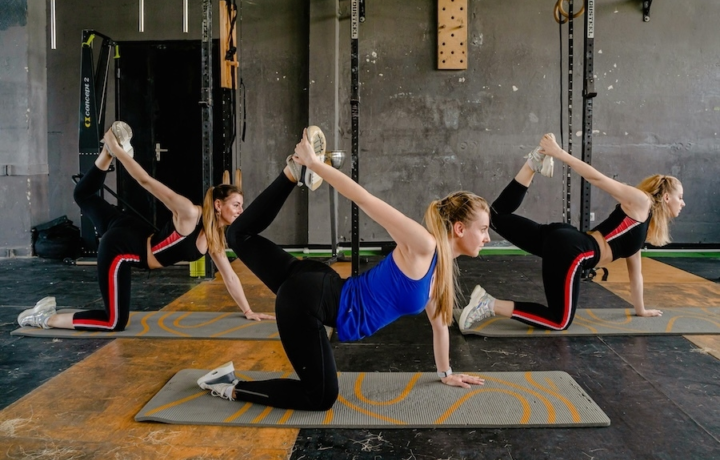Exercise
Roll Hip Stretch

Roll Hip Stretch
How to Perform
- Lie flat on your back with both knees bent and feet flat on the floor about hip-width apart.
- Drop both knees to one side, allowing them to rest on the ground while keeping your shoulders firmly pressed into the floor.
- Extend the arm on the same side as your knees out to the side at shoulder level, and extend your opposite arm straight up toward the ceiling.
- Inhale deeply, then exhale as you use your core muscles to roll your hips back to center, keeping your feet in contact with the floor.
- Continue the rolling motion by dropping your knees to the opposite side while maintaining shoulder contact with the floor throughout the movement.
- Adjust your arm positions by extending the arm on the same side as your knees and positioning the opposite arm toward the ceiling.
- Move slowly through the full range of motion, breathing deeply and using the exhale phase to enhance the stretch across your lower back and hips.
- Complete the prescribed number of repetitions, maintaining a controlled tempo and focusing on the sensation of the muscles stretching along your spine and hips.
Important information
- Keep your shoulders pressed firmly into the floor throughout the entire movement to maximize the stretch in your hips and spine.
- If you feel any pinching or sharp pain in your lower back, reduce the range of motion by not lowering your knees as far to the sides.
- Focus on breathing deeply into your diaphragm to help relax the muscles being stretched.
- For a deeper stretch, try bringing your knees closer to your chest before rolling them to each side.

Roll Hip Stretch
Exercise Details
Primary Muscles
Mechanic
Built for progress
Take the guesswork out of training
Create personalized AI-powered workout plans that evolve with you. Train smarter, track every rep and keep moving forward, one workout at a time.






The Roll Hip Stretch offers an excellent way to release tension in the hip flexors while improving mobility in this critical joint. This gentle yet effective technique is perfectly suited for beginners looking to enhance their flexibility and movement quality without overwhelming physical demands. As a foundational mobility exercise, it targets the hip flexors—muscles that commonly tighten due to prolonged sitting and daily activities—making it an essential component of any well-rounded fitness routine.
This stretch serves multiple purposes in your fitness regimen, functioning beautifully as part of your warm-up sequence to prepare the hips for more intense movement patterns. Equally valuable during cool-down periods, it helps the body transition back to a resting state while promoting recovery by increasing blood flow to the worked muscles. Many experienced athletes and fitness enthusiasts also incorporate this stretch into dedicated recovery sessions between training days to maintain hip health.
The Roll Hip Stretch represents the intersection of stretching and mobility work, addressing not just muscle length but also joint function. While static stretching focuses primarily on lengthening muscles, this rolling technique adds a dynamic element that encourages the hip joint to move through various angles and positions. This comprehensive approach helps break up adhesions in the connective tissue surrounding the hip while signaling the nervous system to allow greater range of motion.
Regular practice of this gentle mobility exercise can yield impressive benefits over time, potentially reducing discomfort from sitting, improving athletic performance, and contributing to better posture by balancing the anterior and posterior muscle groups of the hip. The accessibility of this stretch makes it particularly valuable for those beginning their fitness journey, though even advanced practitioners return to this fundamental movement as part of their maintenance routine. By incorporating the Roll Hip Stretch into your regular practice, you're making a simple yet powerful investment in your long-term movement quality and joint health.
FAQ - Roll Hip Stretch
The Roll Hip Stretch primarily targets the hip flexors, including the psoas and iliacus muscles. It also engages the surrounding hip musculature like the tensor fasciae latae (TFL) and portions of the quadriceps, making it effective for addressing anterior hip tightness.
You can safely perform this stretch daily, especially if you spend long hours sitting. For optimal results, incorporate it into your warm-up routine before workouts and as part of your recovery sessions 3-4 times per week, holding each position for 20-30 seconds.
Yes, this stretch can help alleviate lower back discomfort by releasing tight hip flexors that often contribute to excessive anterior pelvic tilt. When the hip flexors are chronically shortened, they can pull on the lower spine, so regular hip mobility work may reduce associated back tension.
The most common errors include rushing through the movement instead of finding and addressing tight spots, compensating with lumbar extension rather than isolating the hip, and applying excessive pressure that causes pain. Focus on controlled, gentle movements and maintain proper core engagement throughout.
If you have knee issues, place a folded towel or thin cushion under your knee for added support, reduce your range of motion to stay within a pain-free zone, and emphasize the rolling aspect rather than static holding positions. Always prioritize comfort over intensity when adapting this or any stretch.


